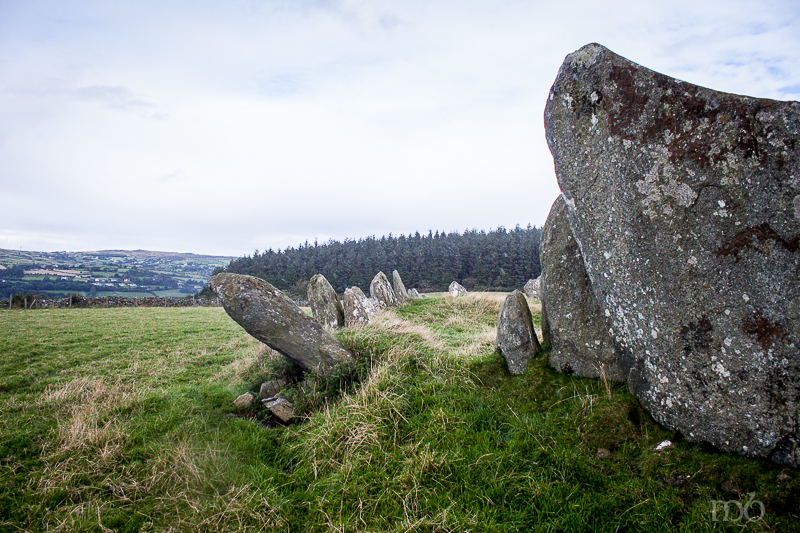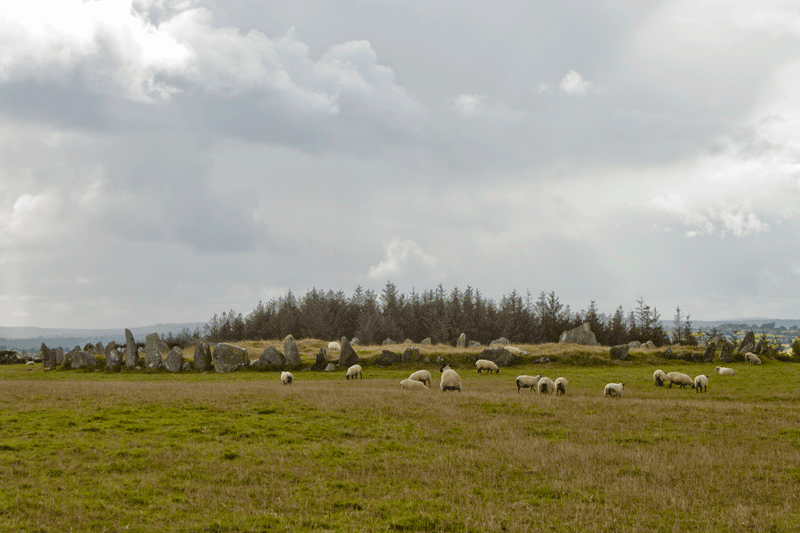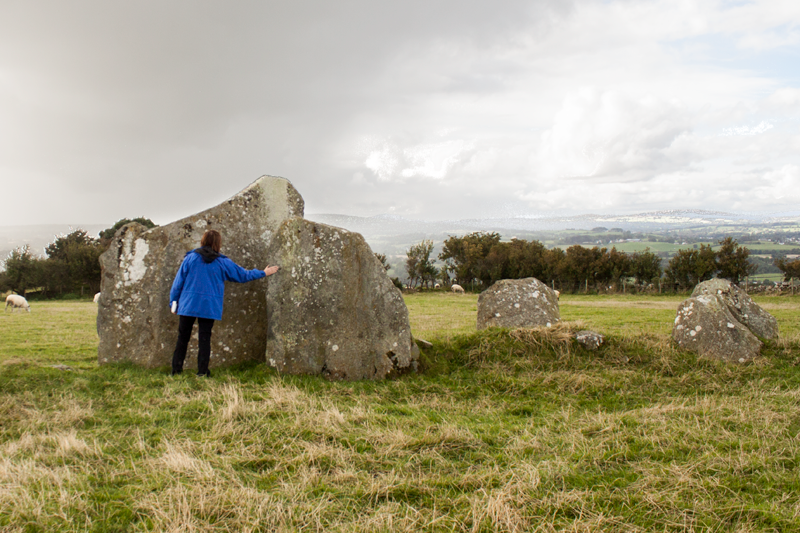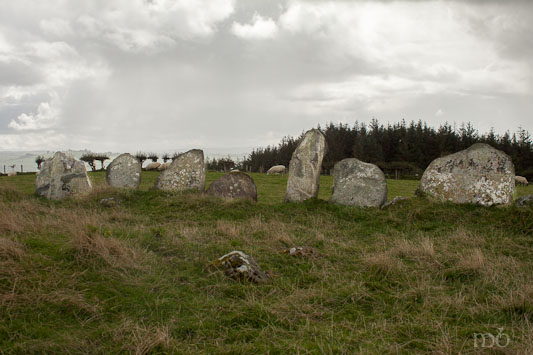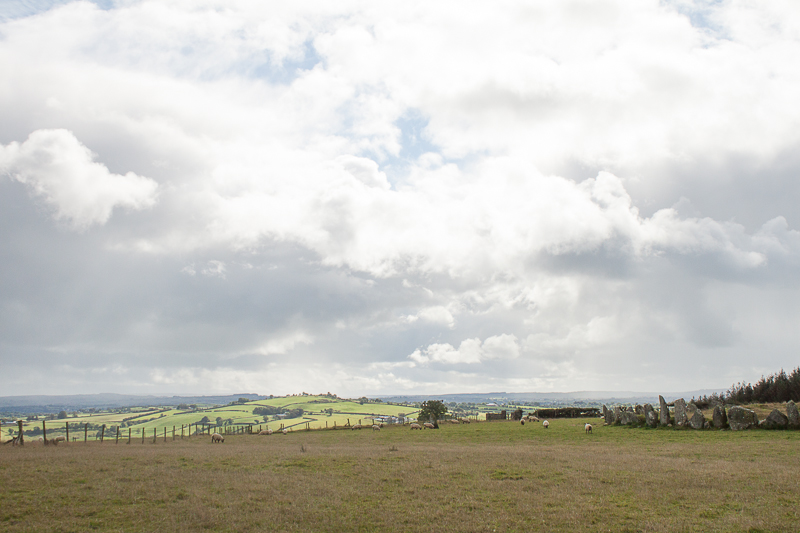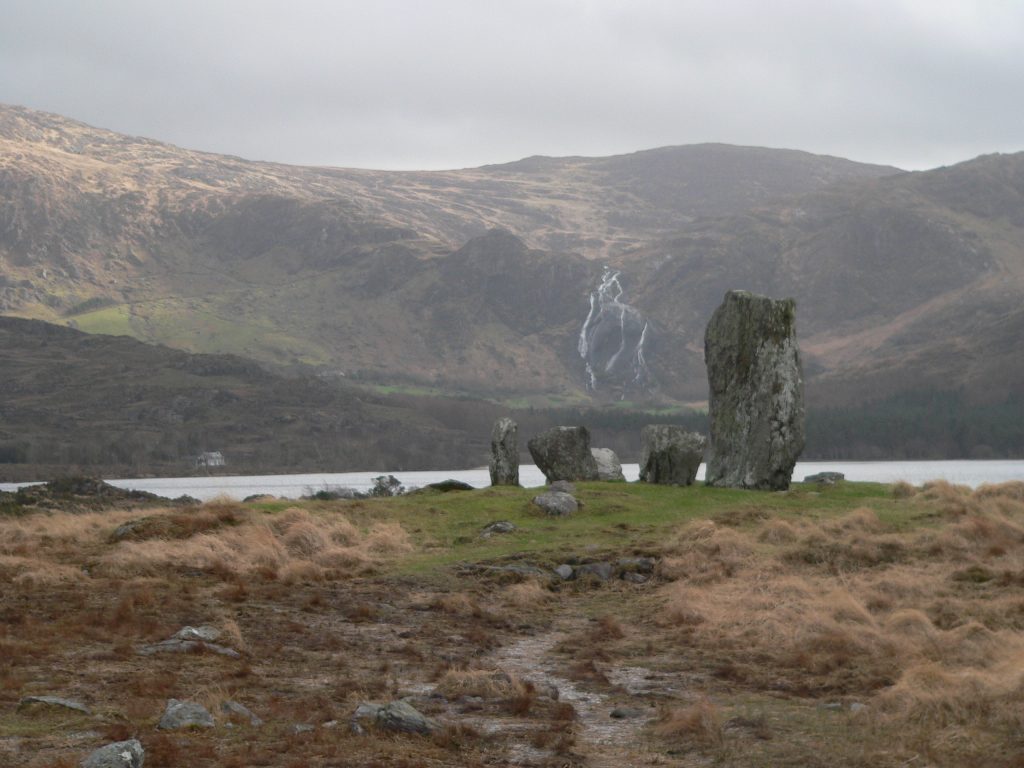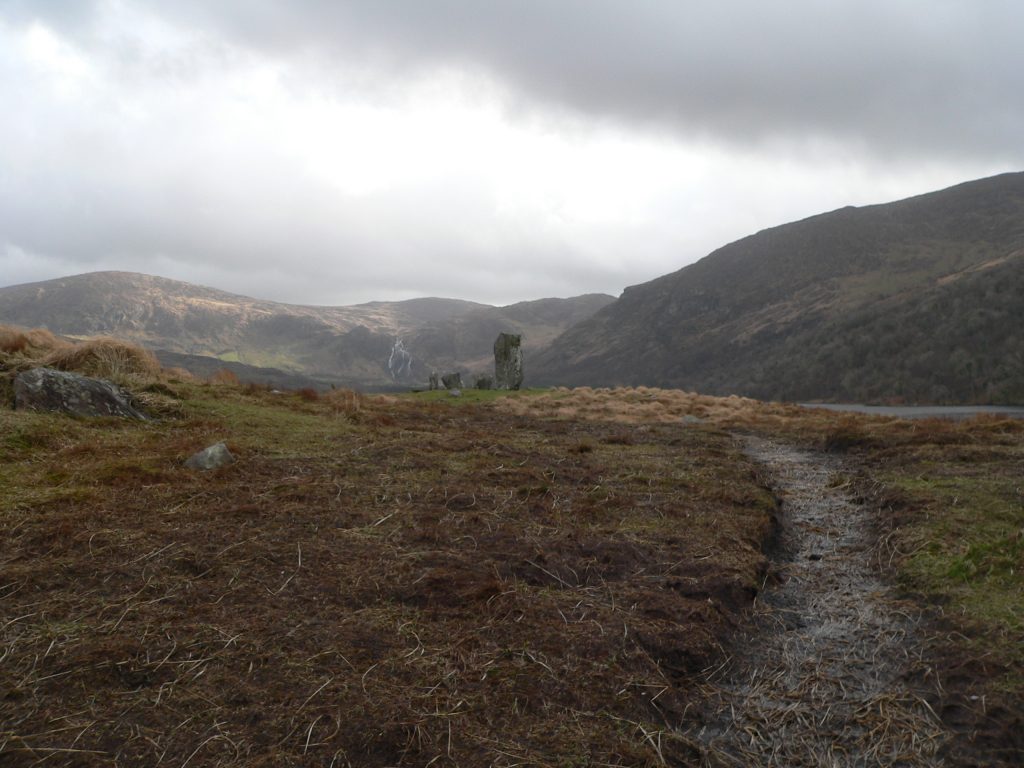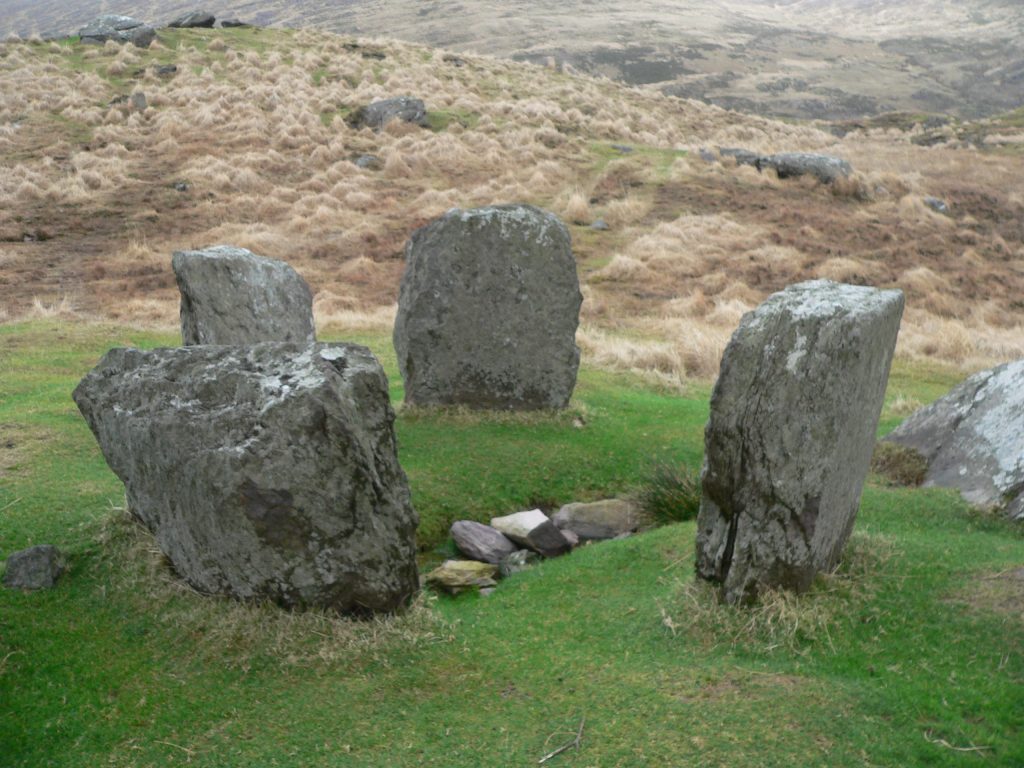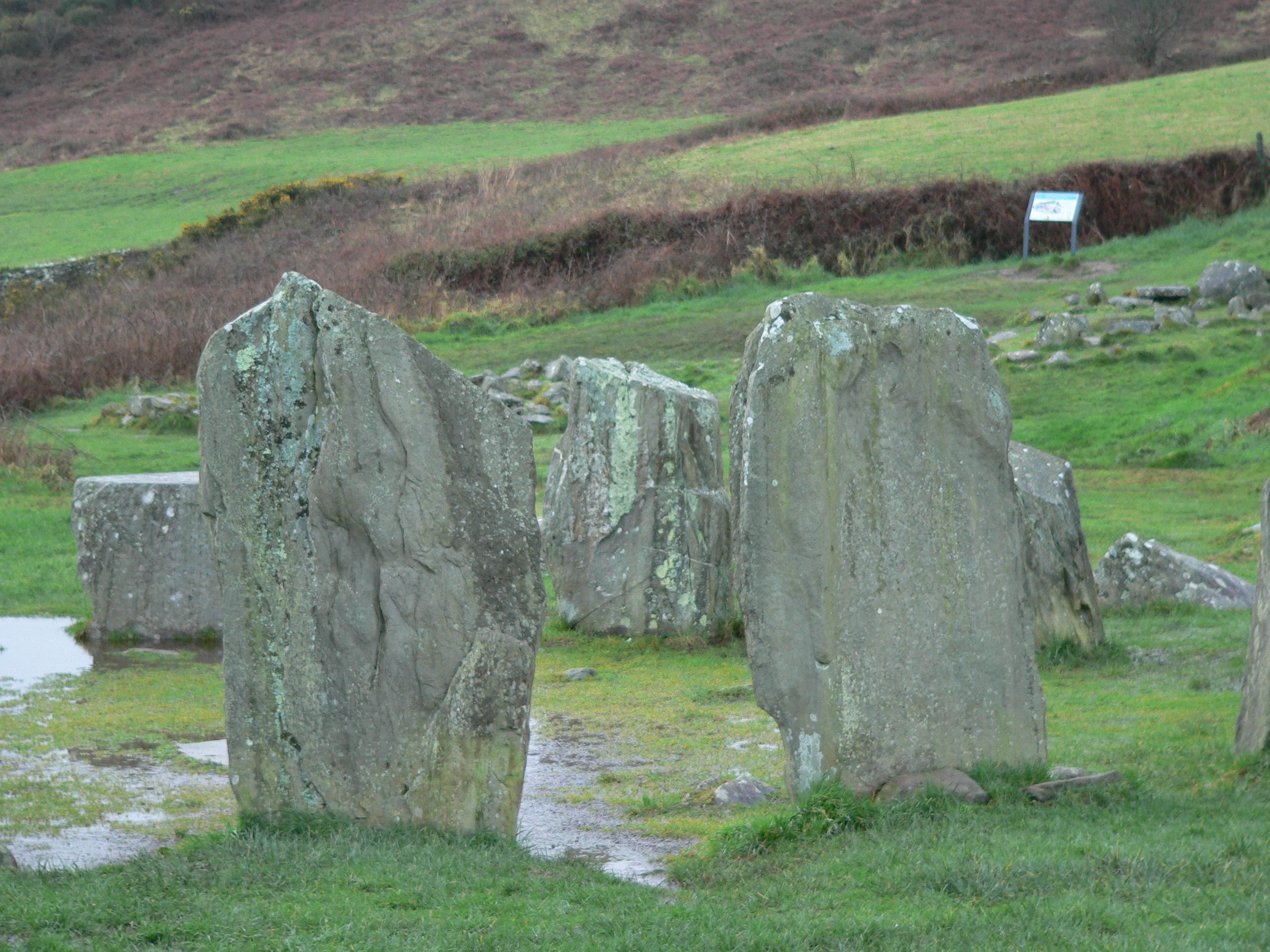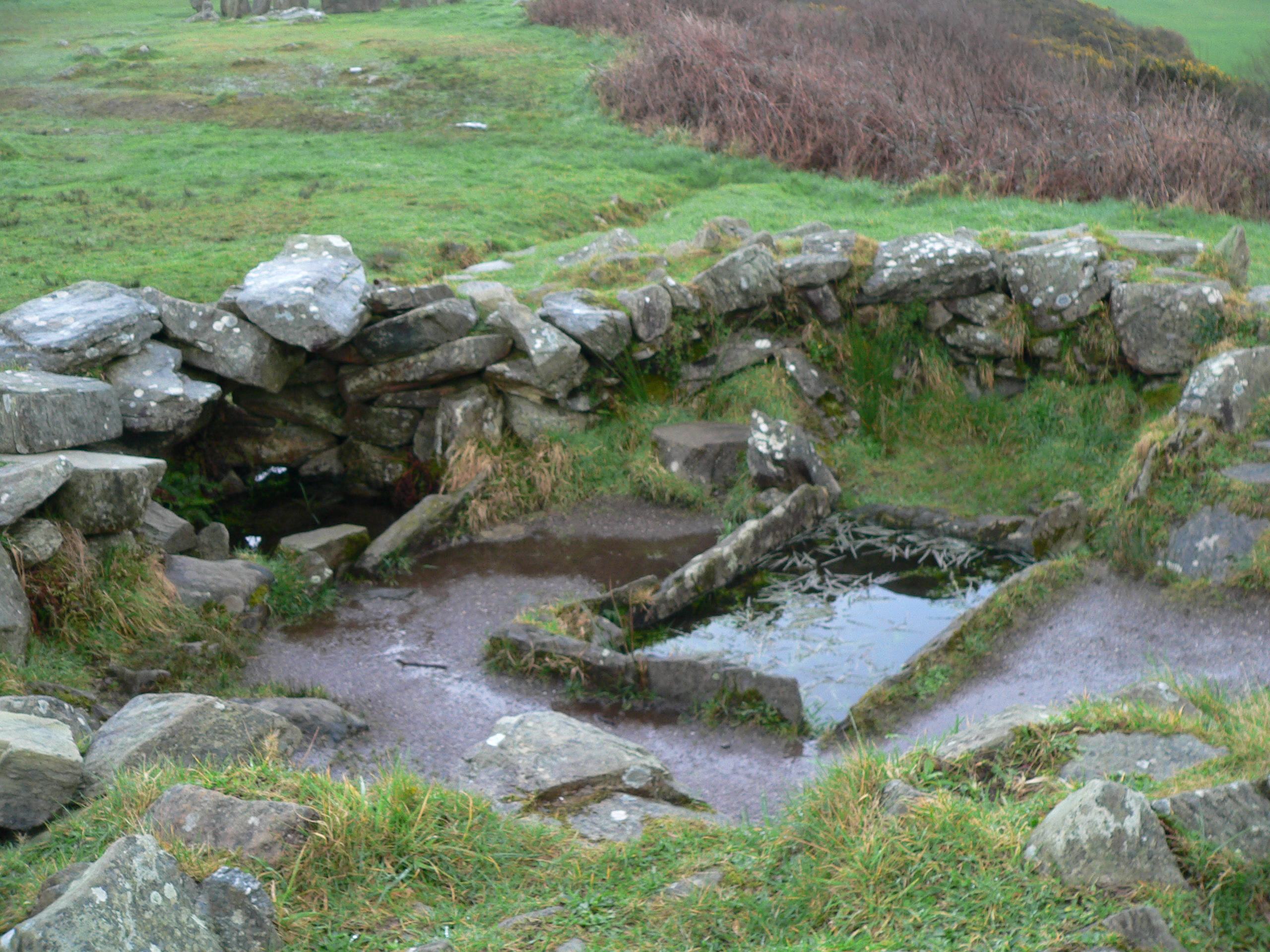A Bridge to the Otherworld – A Rainbow at Beltany
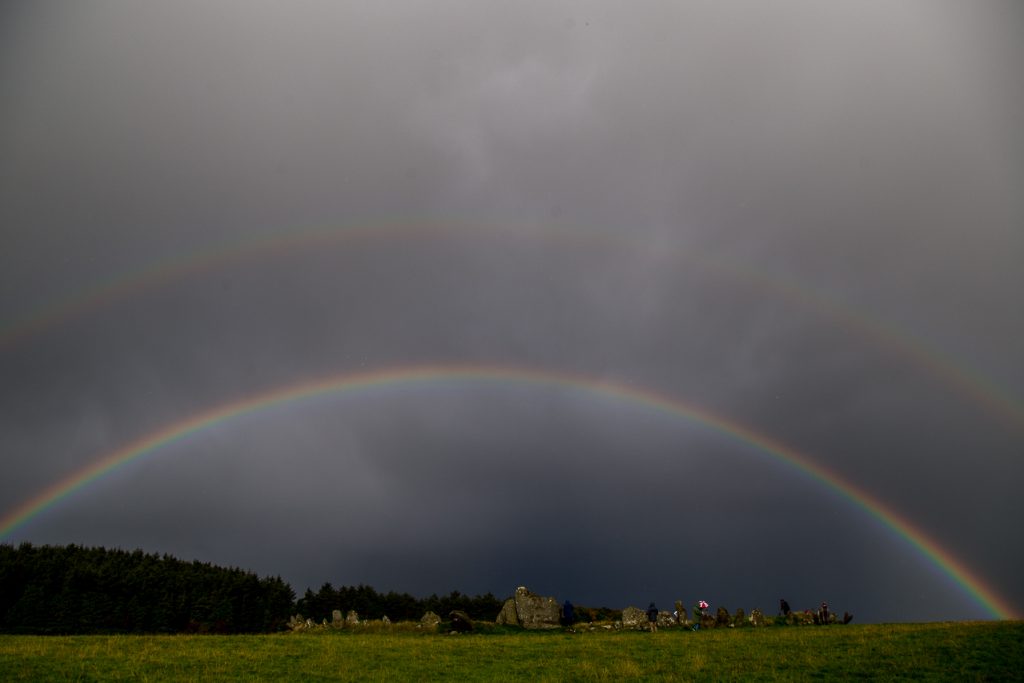
It appeared as if it was a bridge to the Otherworld… the rainbow we saw at Beltany stone circle on the eve of the Autumnal Equinox. The vision was certainly otherworldly. After seeing such a display there’s always the urge to make some kind of sense of it. To find some meaning.
Every culture has its own symbolic meaning for the rainbow. Most traditions focus on connection, a bridge to the otherworld, a promise from God, a sign of hope, a call to follow one’s heart. On the eve of the Autumn Equinox, I led a group up the path to Beltany stone circle in County Donegal. It was wet, rainy and overcast. The field approaching the circle was littered with cow dung. Several of my group turned back finding nothing particularly mystical about Beltany. But for those of us who stayed, the landscape shifted dramatically within fifteen short minutes.
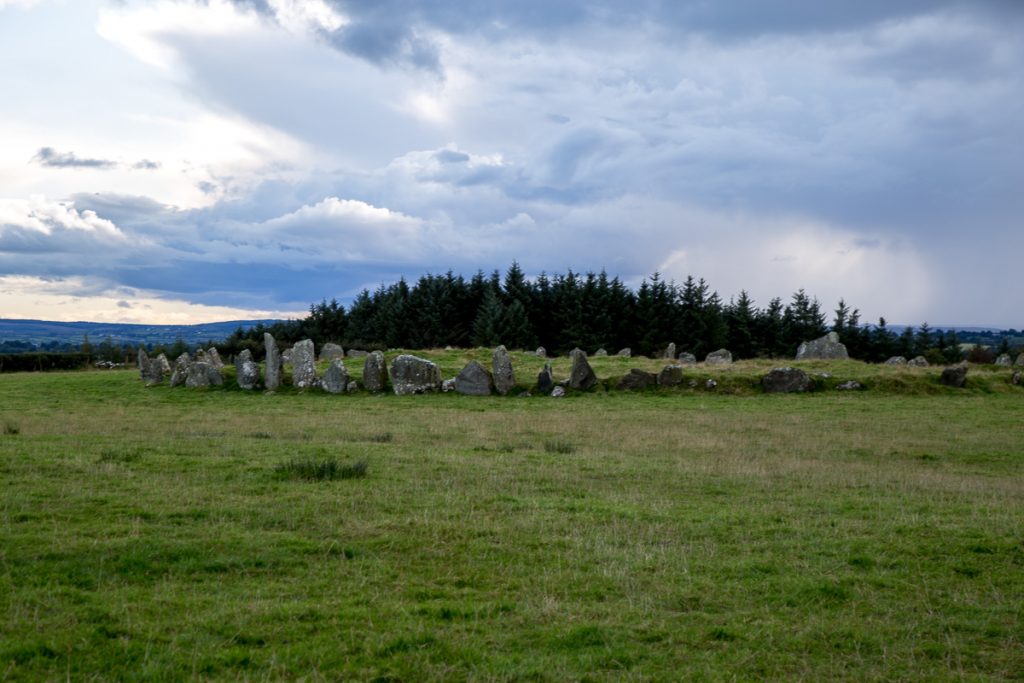
Beltany stone circle dates back to 1400 – 800 BC. With its 64 stones averaging 6 feet in height, it is larger than most found in Ireland. The circle measures about 145 feet in diameter. The site was significantly disrupted during an early twentieth-century excavation leaving the center of the circle lumpy with stones now covered by grass.
Most believe that there were at least 80 stones in the original circle. A wide triangular stone with cup markings immediately draws the eye and stands out from the others (shown to the right in the image above). It faces ENE and stands directly across the circle from the tallest stone (about six feet high) which points WSW. When the two stones align they point to the summit of a hill across the valley. On May 1st – the feast of Bealtaine – that the sun rises over that hill and aligns with these two stones. The circle’s name, “Beltany” likely refers to this celestial event and the feast of Bealtaine.
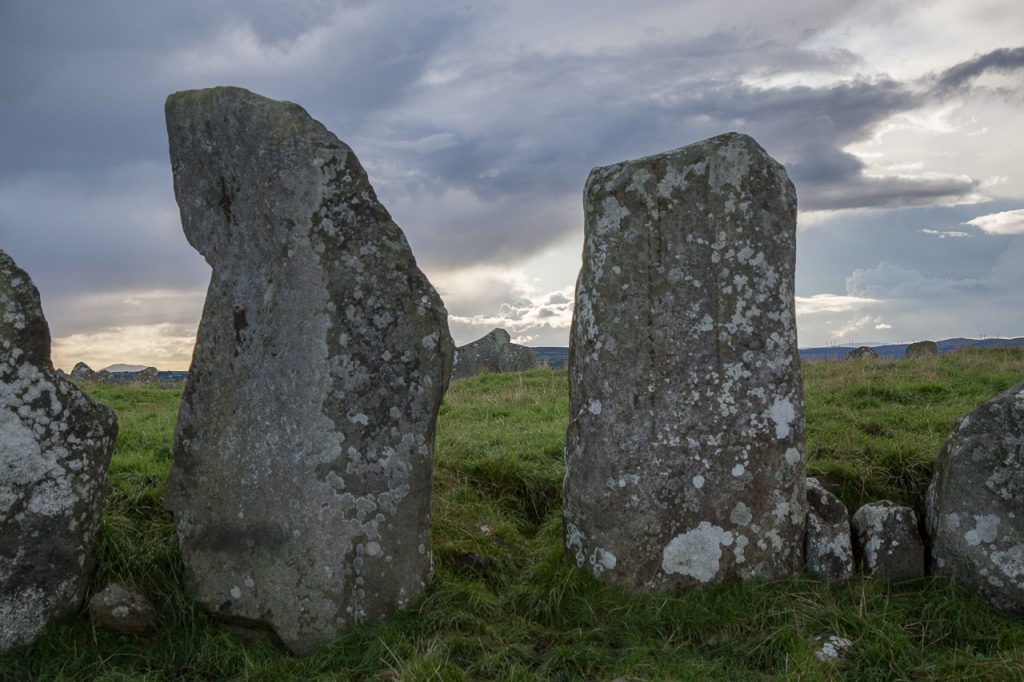
The Rainbow at Beltany
As we walked up the secluded path to the open field where the circle stands, my tour group was tired, the skies were gray and there was a slight drizzle. I was disappointed because I wanted my guest to love the circle as much as I did, but I could see that some of them remained on the bus and others exited quickly due to the difficulty of walking through a wet cattle field. I had only a portion of the tour group at the circle. Then it started to pour.
My heart sank. I want so much for this to be a perfect experience. But sometimes the weather won’t cooperate.
But sometimes the weather and the landscape surprises us.
As the rain softened, I happened to turn around toward the entrance to the field. I saw a pretty vibrant rainbow that was halfway across the sky. I called out to my tour guests to look at it. No one said a word – we just stared.
Then together we watched this rainbow spread perfectly across the sky over the circle. Then a second one appeared over the first. The clarity of the colors was stunning. Then we noticed that there was a darkness or shadow between the two bows. The space between was charcoal colored – different from the sky making the set of rainbows appear to be one thing.
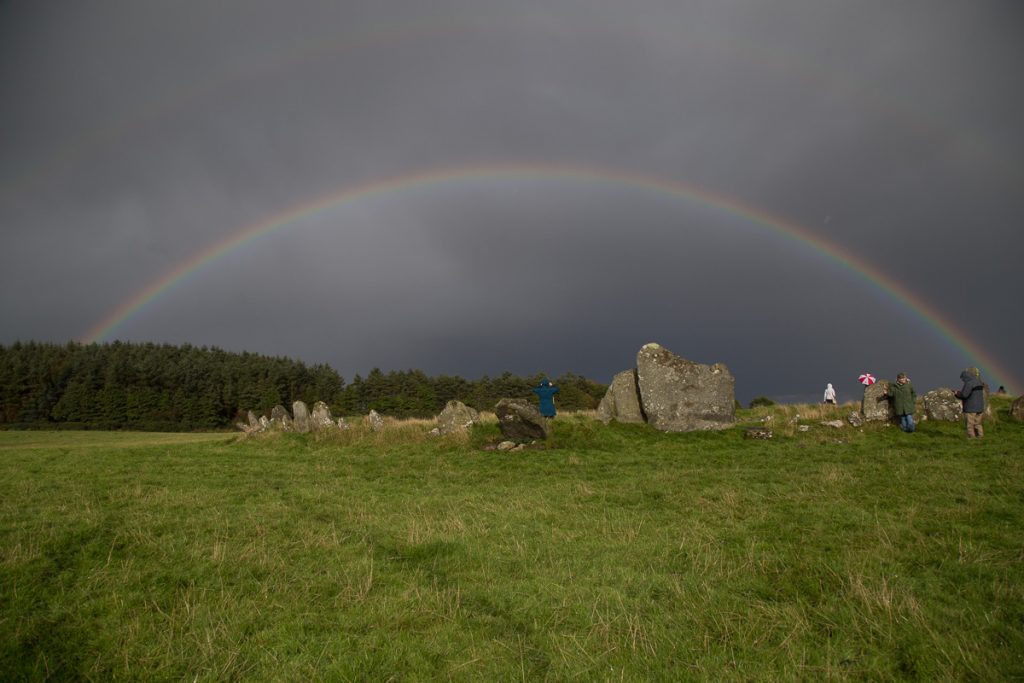
Even the sheep in the field were looking up at the rainbow.
One of my guests said, “In my seventy-one years of life, I have never seen anything like this.” It almost seemed as you could walk out to the end and touch the rainbow. Then the same guest pointed out that the colors were reversed on the second rainbow. Each rainbow was a reflection of the other with the colors going in opposite order – a perfect reflection – a mirror image. Traces of a third rainbow could be seen at the edges of the second.
The Symbolic Meanings of a Rainbow
A rainbow is a fusion of light that projects a harmonious – almost supernatural specter of all the world’s colors visible to the human eye. Every culture in every time has been moved by the sight of the rainbow. It nudges us to find some meaning in the presentation of something so spectacular. The Judeo Christian tradition is rooted in the book of Genesis.
It shall be, when I bring a cloud over the earth, that the rainbow shall be seen in the cloud; and I will remember My covenant which is between Me and you and every living creature of all flesh; the waters shall never again become a flood to destroy all flesh.Genesis 9:14-15
The first nations in North America, as well as many Asian cultures, saw the rainbow as a bridge or passage between the earthly and spirit worlds.
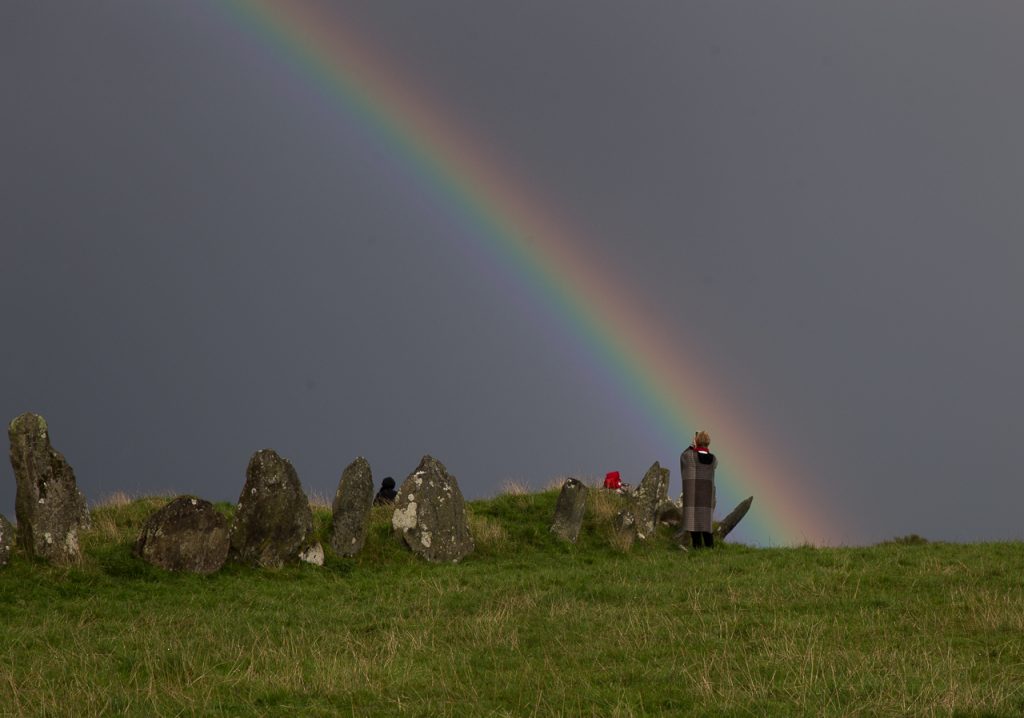
The ancient Irish or pre-Christian Irish saw the rainbow as a sign of blessing – the arc symbolized femininity – the rounded belly about to give birth, which is so appropriate for Beltany because the circle was likely created to celebrate that feast which encourages and blesses fertility and birth. The rainbow was often interpreted as a promise of good luck, abundance a sign to follow the heart’s desire or follow your dreams.
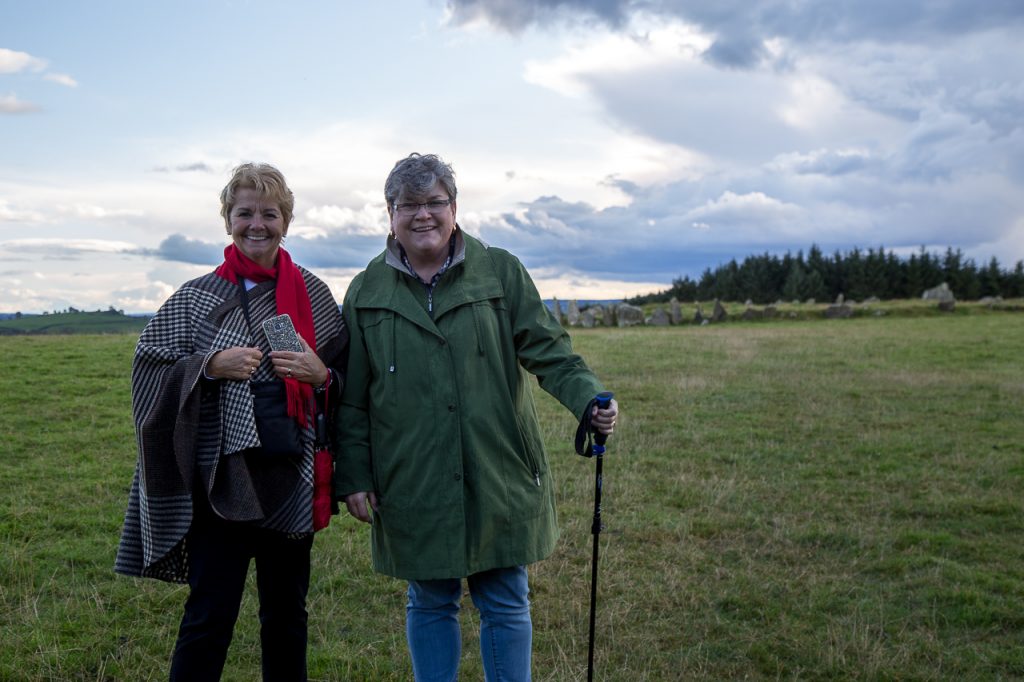
Guests on Discover the North tour after the rainbow
We’ve all heard of the old Irish saying to follow the rainbow and find the “pot of gold.” The rainbow was often interpreted as a promise of good luck, abundance a sign to follow the heart’s desire or follow your dreams. And standing at the edge of that circle and seeing the pulsing vibration of light against the field, one can perceive an actual “physical” end of the rainbow. Almost as if the pot of gold could be within reach. The light is mesmerizing.
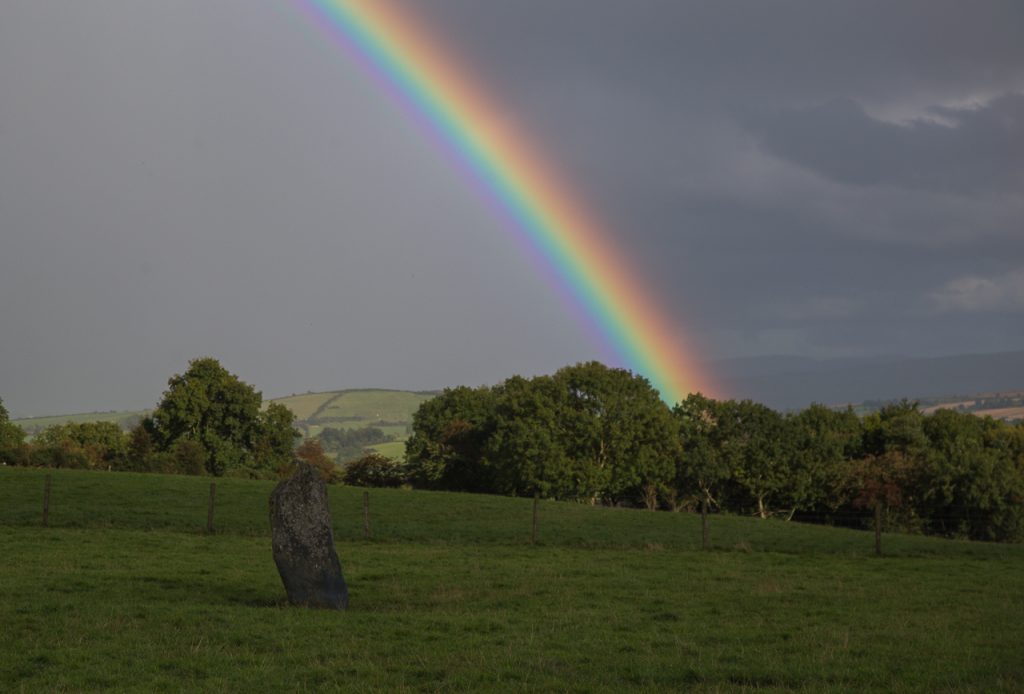
I love the kitschy words of the song from the musical Finian’s Rainbow
Look, look, look to the rainbow
Follow it over the hill and stream.
Look, look, look to the rainbow
Follow the fella’ who follows a dream
In the end, it doesn’t really matter what the rainbow means or doesn’t mean. Just standing in the presence of such a sight was gift enough for me. And it will always be a part of my memories of Beltany.
Beltany Stone Circle – Thin Place in Co. Donegal
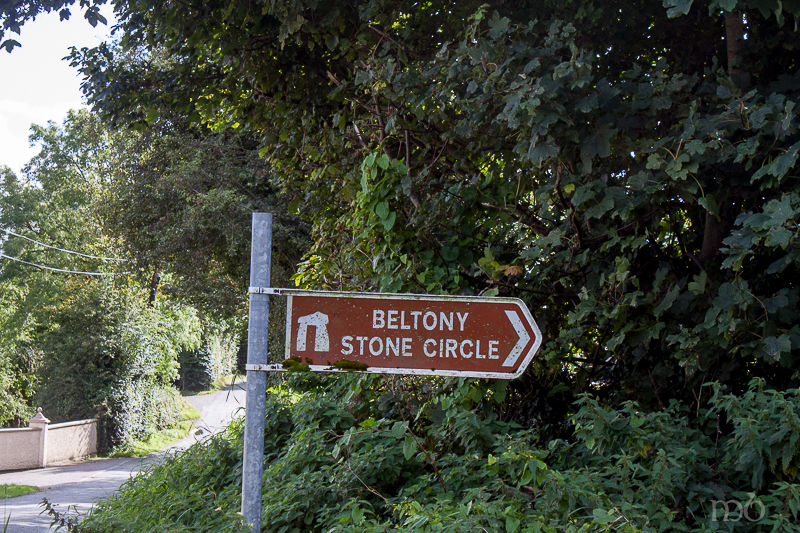 If a thin place is one where the veil between this world and the eternal world is “thin,” then Beltany Stone Circle in County Donegal ranks as one of the thinnest or most mystical sites in all of Ireland.
If a thin place is one where the veil between this world and the eternal world is “thin,” then Beltany Stone Circle in County Donegal ranks as one of the thinnest or most mystical sites in all of Ireland.
The circle dates back to 1400 – 800 BC, and is larger than most found in Ireland having 64 stones averaging 6 ft. in height. The circle measures about 145 feet in diameter. The site was excavated in the early twentieth century and significantly disrupted. Most believe that there were at least 80 stones in the original circle. These stones are orthostats – stones set against a rise or wall. They stand close together hemming in a raised earthen area resembling a kind of kerbing as seen in passage tombs. Some suspect that the circle and its center mounds could have comprised some kind of burial site that may have once been covered with earth. Others think the center “lumpiness” is a result of the disheveled condition the excavators left the site in back in the early 1900s.
The name Beltany is an Anglicization of the Irish word Bealtaine which is the feast of fire or rekindling the sun. Bealtaine festivals are celebrated on May 1st which is also the beginning of summer in the Celtic year. May 1st is the halfway point between the Spring equinox (the day when light and darkness are equal in hours) and the Summer Solstice (the longest day of daylight). The rituals on this day were linked to fire, particularly on hill tops across the landscape. Some believe this was a kind of refueling or re-firing the sun, or a form of worship that called down a blessing on the land and crops from the god of the sun.
The Beltany stone circle is located on Tops Hill. A wooded path (often muddy) leads from a car park to the summit. At the end of the shaded path, the landscape opens wide and in the distance, in a lone field one can see the jagged points of stones in a large stone circle. The transition from path to field feels much like a portal. There is a defined energy in this fields that grows stronger as one approaches the circle.
But there are two interesting stones in the circle that suggest it was used for measuring the seasons using astrological alignments, and possibly used for rituals related to the sun or sun god. These would be the tallest stone in the circle and the widest – the triangular stone with cup markings.
Most of the stones are tall and cylindrical in shape listing to one side or the other of the circle line. They resemble jagged old teeth. But the wide triangular stone, stands out. It’s special and immediately draws the eye. Additionally, it has cup markings on the inner face carved into it long ago. It faces ENE and stands directly across the circle from the tallest stone (about six feet high) which points WSW. When the two stones align they point to the summit of a hill about five miles away in Tullyrap – a summit where the sun rises directly over on May 1st – the feast of Bealtaine.
There are also noticeable outliers which may also have had a significance. According to Cary Meehan in her book A Travelers Guide to Sacred Ireland, “a line from the tallest stone in the south western part of the circle taken through the outlier, goes 28 miles south east to Bessy Bell Hill in Tyrone. Another line could run through the circle to Croaghan Hill, 4 miles ESE. ”
So Beltany Stone Circle could have been a passage tomb(s) or a tool for charting the agricultural seasons. It may have been aligned with other sacred sites. We know it was used for celebrations specifically linked to Bealtaine. Three carved stone heads dating to the Iron Age were found at Beltany during the excavation. They indicate that the circle was used for many centuries.
Today, though it’s been disrupted and disheveled, it still sits in place – marking the spot so many believed to be sacred. There site is still charged with energy. Even in the pouring rain, it offers a sense of thinness, of being in two worlds at one time.
Beltany Stone Circle is on the Images in the Landscape Tour in 2018.
Uragh Stone Circle on the Beara Peninsula – Enchanting
The Beara Peninsula which straddles Counties Cork and Kerry has some of the most mystical sites in Ireland scattered over its terrain. The Uragh Stone Circle, not too far off the main road from Kenmare to Ardgroom is one such site. The circle has 5 small stones and one large alignment stone. Surprisingly, this stone circle doesn’t appear in guidebooks or local destination publications. I only found it due to the signage along the roadside. This site is well worth traveling thousands of miles – just for the view and the energy in the place itself.
The circle rests on a small hill that sits between two lakes – Cloonee Lough Upper and Loch Inchiquin. The back drop is of mountains, veined by waterfalls. I noticed the colors of the mountains continually change as the ever-moving sunlight shifts. The effect is similar to a kaleidoscope with muted earth tones. Stand still and watch the landscape change.
A dirt road reaches the circle, and one must cross a bridge to get to the hillock. When I was there it was damp and muddy. Traversing up the hill to the circle required boots, but well worth the challenging mud holes. Standing on the hill near the circle I could see that this was the center of the vast landscape all around. The view over Loch Inchiquin is spectacular.
This spot is magical.
The circle itself has 5 stones tangentially placed and one great alignment stone that appears to line up with the axial stone though very close in proximity. The massive alignment stone is over 10 feet high. It dwarfs every other element of the landscape.
It’s easy to imaging Uragh Stone Circle as a portal to another place or another realm. The changing light, the shifting colors, the solitary setting of the circle – all these elements consume the spirit. I lost track of time while there. After awhile a young couple walked up the dirt road from the opposite direction – past the circle. They said they’d been watching me from the hillside. I seemed so determined to reach the circle through the mud. So they came out for a walk. They were vacationing there on Beara for a week. When I asked where they were from, they replied Washington DC (just 35 miles from my home at the time).
Strange coincidences tend to occur in thin places.
Drombeg Stone Circle – County Cork
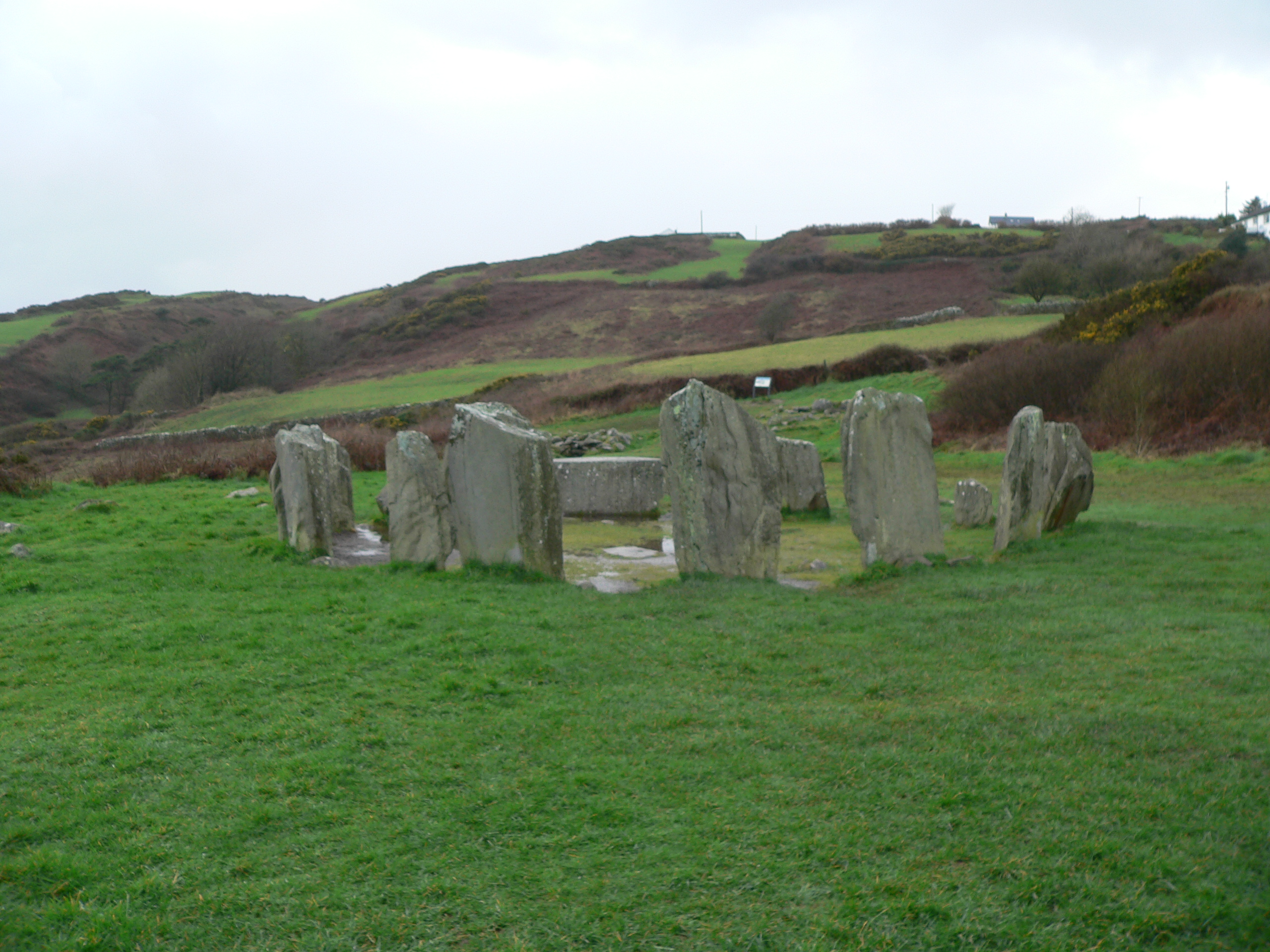
Drombeg Stone Circle – County Cork
The area in southwest Ireland – West Cork and much of Kerry – has over 100 prehistoric stone circles. What was the purpose of these circles and how were they used? One can only speculate. Reading the seasons, sacred worship, sacrificial offerings, astronomical clocks, burial grounds … these are just some of the uses the pre-Christian people of Ireland had for these stone circles. But there’s much more about the circles we still don’t know.
The circles in this region all have an odd number of stones. Drombeg has 13 – but it originally had 17. Most of the Cork / Kerry circles follow a specific astronomical orientation, having an axial stone (usually a lower, shorter stone in the circle) on the western edge opposite a set of entrance or portal stones (usually taller) on the eastern edge. The axial stone is also called the recumbent stone. In the photo above, the two portal stones are in the center of the photo and the lower, axial stone can be seen between them on the opposite side of the circle.
A Winter Solstice Light Show
You can barely see the little notch in the hills behind the circle, but the hills define a sort of “V” on the horizon. On the winter solstice (Dec 21 – the shortest day of the year), the sun dips just under the ridge of that V in the hills, but as the earth moves the sun comes into the V in near perfect alignment with the axial and entrance stones – shooting its concentrated rays directly across the center of the circle. Accounts by people who have seen this process state that it looks as if for a few moments, the circle itself is illuminated independently of the surrounding landscape.
Why would this process have been important to these ancient people?
The Ridge is Man-Made
Excavations around the site back in the 1950s showed buried human cremated bones near the center of the circle coupled with broken pottery shards and stones. There were other burial pits near the circle with the same combination. Oddly, the shards of pottery and the stones seemed to be as revered in burial as the human bones. Excavation also proved that the plateau where the circle rests (Drombeg means “small ridge”) is man made. The people who built this circle evidently leveled the land – or ridge – to affect the perfect winter solstice drama that occurred in the circle during sunset.
Prehistoric Huts Nearby
In the same complex, near the stone circle are the remains of two prehistoric huts that were probably used for cooking – what we might call a “commercial kitchen” today. One of the huts had a capacity to boil about 70 gallons of water. Hot rocks from a fire were placed into a rectangular stone basin and within 20 minutes the water would come to a boil and remain hot for about 3 hours. This was probably how the ancient people boiled their meat. Remains of what was probably an oven are in the second circular hut. This tells us that the area wasn’t just a place to read the seasons or practice sacred ritual. The circle would have been a place of community.
The Drombeg complex is located between Skibbereen and Kinsale, and is easy to access with parking relatively close to the site. My first visit to Drombeg was in February of 2007. It was a cold, dreary, rainy day. I arrived tired. It was my last site of the day. The time was 5:00 pm. As I approached the site from the car park, I was unimpressed at first. The site seemed to have no sense of place. In fact, save for the shadows from the stone circle, the site looked like another farm field with houses nearby.
But as I walked into the complex and took in the surroundings, the place became magical. This is a site worth visiting. Take some time to gather your senses about you and notice everything about the surroundings – the distant hills, the views of the sea, the sounds, the light, the stones themselves. Then when your sensitivities are peaked, enter the circle through the Portal stone entrance.
The following is from my travel journal which is mostly transcribed recordings of impressions I dictated into a digital recorder during the visit.
I take back what I said about this site being unimpressive. The stone circle is beautiful. It’s in a big clearing where the entire valley just unfolds as you approach the circle. And there are views of the sea – the Celtic Sea.
There are hills and hills of green. Expansive sky. It’s a big wide area. It’s a beautiful stone circle. The stones are thick and tall.
Walking through the entrance of the Drombeg portal stones is pretty powerful. You walk in through the center and you can feel it. There’s just something sacred about the center of the circle.. I noticed the axial stone had two notches. There is energy here. Old energy. Ancient energy.
Drombeg Stone Circle is a very thin place. It is one of the stops on the Thin Places Mystical Tour of Ireland – May 15 – 24, 2011. Full Tour Itinerary. Make your reservations today.
Beara – Cashelkeelty Stone Circle
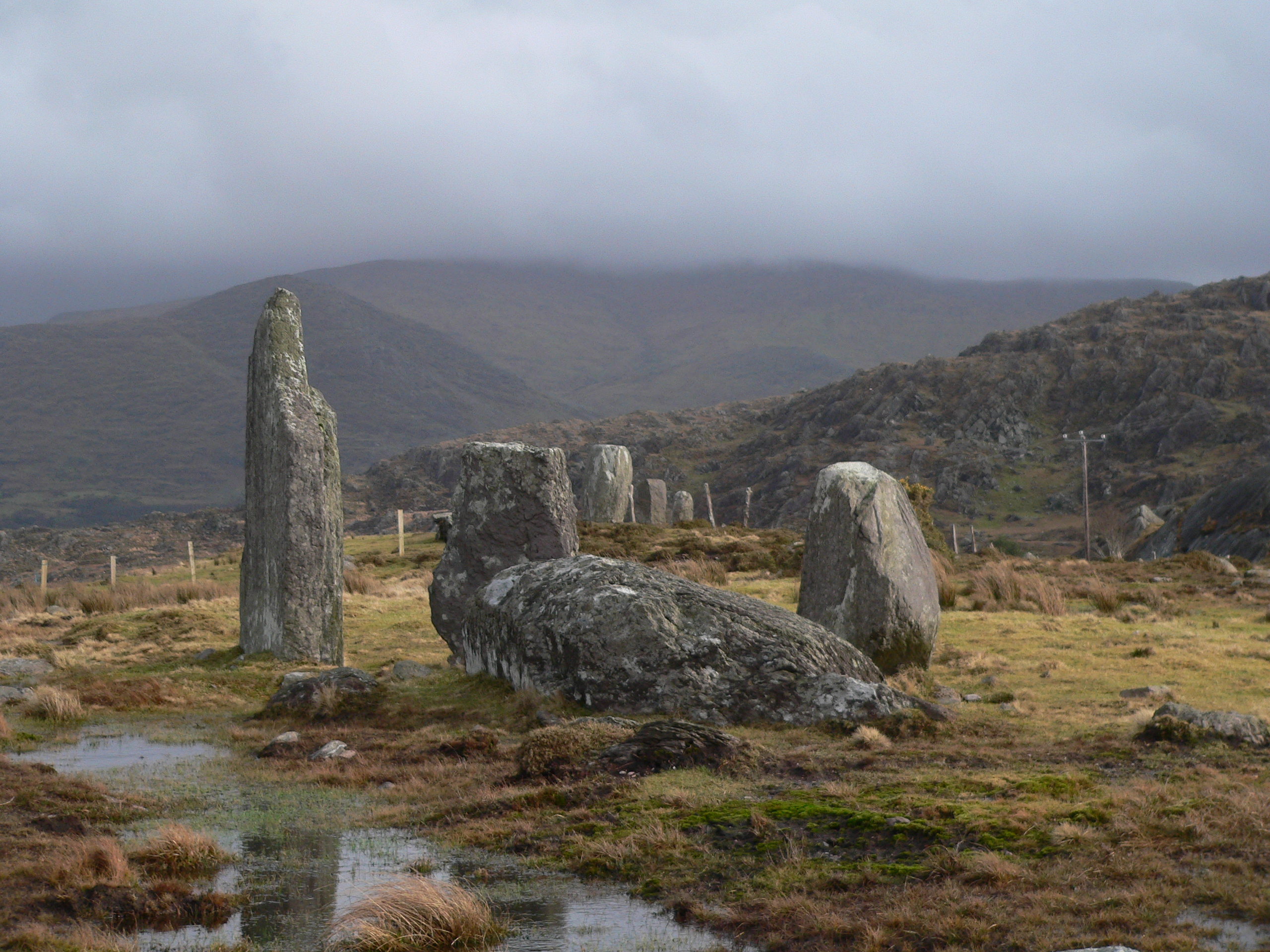 Nine hundred years before Christ was born, people of south western Ireland erected a group of alignment stones in a rocky outcropping on what is now known as the Beara Peninsula. The location was set along an ancient track, known as the Green Road, that spanned a good part of the peninsula, connecting communities. Only three stones remain today from the alignment group. Remnants of a smaller stone circle nearby mind pilgrims as they step into that thin place. The panoramic views near the alignment stones are vast, and one can see the sea in the distance.
Nine hundred years before Christ was born, people of south western Ireland erected a group of alignment stones in a rocky outcropping on what is now known as the Beara Peninsula. The location was set along an ancient track, known as the Green Road, that spanned a good part of the peninsula, connecting communities. Only three stones remain today from the alignment group. Remnants of a smaller stone circle nearby mind pilgrims as they step into that thin place. The panoramic views near the alignment stones are vast, and one can see the sea in the distance.
Cashelkeelty Stone Circle is like no other I’ve visited. Though guide and reference books give it no significant rank over other circles, it has an existing spiritual presence that surpasses the others – at least for me. One can feel the history ascending the final hill along the Green Road. The first glimpse of the circle at the crest of the hill marks the point when time begins to stand still for the pilgrim… when that traveler coming to this place in the context of an ancient story steps into a higher level of her own existence. I was overcome by emotion when I moved close to the tallest stone. At eight feet high, this stone hovers over the others looking like a bard recounting a meaningful story. I don’t know how long I was there. But the pictures I shot show I was there through a bit of a weather change – darkness, sunlight, fog, mist, rainbows, all shifting in and out of time.
It is impossible to take a bad photograph here.
I ascended the Green Road alone when I visited the circle. I was traveling by myself that rainy February afternoon. I studied the stones, standing in front of them – looking, staring. It’s remarkable what you can see when you stop to notice details. I noticed scores of coins that had been tucked into the stone crevices – coins from many countries. I looked further and noticed cairns that had been erected by pilgrims near the stones, clooties left behind, tokens under stones – confirmation that I wasn’t alone, at least not alone in knowing that this place was special.
Cashelkeelty Stone Circle is one of the sites on the itinerary of the Thin Places Mystical Tour this September. Come join us.
